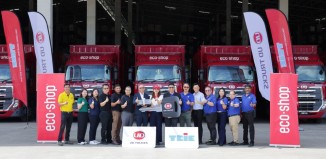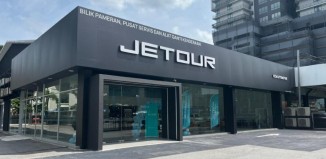SOCAR Welcomes MoF Intention To Drive Green Transportation And Economy In Budget 2022
Recently, the Minister of Finance (MoF) Tengku Datuk Seri Zafrul Abdul Aziz said that the government will look into policies related to the financing of sustainability and the green economy in Budget 2022. This includes short to long term policies for sustainability development that will help strengthen financial stability and the economy, particularly socioeconomic like poverty, in view of the impact of climate change.
Responding to the minister’s statement, Group CEO Leon Foong said that SOCAR Mobility Asia warmly welcomes the Government’s commitment to strengthening and widening sustainability-related financing in the upcoming Budget 2022.
 “As the Minister of Finance Tengku Datuk Seri Zafrul Abdul Aziz recently said, a whole of nation approach is crucial in developing key policies for sustainable development. As a company committed to expanding access to mobility options and also a believer that transportation can be fully carbon neutral in the future, SOCAR is firmly committed to and highly supportive of policies and incentives that encourage low-carbon mobility and investments into the sustainable infrastructure that supports green transportation systems in a vibrant green economy,” said Leon.
“As the Minister of Finance Tengku Datuk Seri Zafrul Abdul Aziz recently said, a whole of nation approach is crucial in developing key policies for sustainable development. As a company committed to expanding access to mobility options and also a believer that transportation can be fully carbon neutral in the future, SOCAR is firmly committed to and highly supportive of policies and incentives that encourage low-carbon mobility and investments into the sustainable infrastructure that supports green transportation systems in a vibrant green economy,” said Leon.
 “In particular, we at SOCAR have long believed that private-public partnerships will be key in accelerating the switch from fossil-fuel powered vehicles to electric vehicles, including driving investment in the battery and charging industries. We urge the Ministry of Finance, through the Sustainable Financing Roadmap, to incentivise the automotive sector and consumers in Malaysia to invest in the massive growth potential of EVs – from the production of EVs, its chargers and batteries, to the creation of a vibrant ecosystem of support services for EV users and even the recycling and repurposing of retired EV batteries for secondary use. With TNB’s plans for a renewable energy composition target of 31% by 2025 and 40% by 2035, we believe that mobility players and government stakeholders will also need to play their parts in ensuring that our vehicles can tap into this greener “grid of the future”, he added.
“In particular, we at SOCAR have long believed that private-public partnerships will be key in accelerating the switch from fossil-fuel powered vehicles to electric vehicles, including driving investment in the battery and charging industries. We urge the Ministry of Finance, through the Sustainable Financing Roadmap, to incentivise the automotive sector and consumers in Malaysia to invest in the massive growth potential of EVs – from the production of EVs, its chargers and batteries, to the creation of a vibrant ecosystem of support services for EV users and even the recycling and repurposing of retired EV batteries for secondary use. With TNB’s plans for a renewable energy composition target of 31% by 2025 and 40% by 2035, we believe that mobility players and government stakeholders will also need to play their parts in ensuring that our vehicles can tap into this greener “grid of the future”, he added.
It is also crucial for private enterprises and relevant ministries and agencies to form close partnerships to strategise efforts for policy standardisation. SOCAR is ready to work with all parties such as the Ministry of International Trade and Industry and its agency, the Malaysia Automotive Robotics and IoT Institute, as well as the Ministry of Environment and Water and its agency, the Malaysian Green Technology and Climate Change Centre, in addition to the Ministry of Finance.
“At SOCAR, we are keen to contribute our resources and expertise towards this collaborative effort. Learning from success stories in EV adoption globally is also key. For example, in Liuzhou, China, a localised focus on the requirements of residents has proven that smaller and more affordable 2-seaters like the Baojun E100 can be a huge catalyst for the electrification of fleets1,” he commented.
 “When it comes to incentivising the switch to EVs and expanding availability of charging infrastructure, the announcement of the Low Carbon Mobility Blueprint 2021-2030 earlier this year was a highly positive and key step2 and we look forward to this being formalised by the cabinet. While the exemption of import duties for fully electric vehicles3 is most helpful, the affordability gap between ICE vehicles and EVs is expected to persist beyond that and there are also challenges when it comes to the availability of fast chargers. We are hopeful that the government can work with industry participants to create an Electric Vehicle digital one-stop shop where all Malaysians can easily understand the total cost of ownership savings from EVs, find their closest fast charging points, pay for charging and claim the tax benefits that come with buying an electric vehicle,” Leon added.
“When it comes to incentivising the switch to EVs and expanding availability of charging infrastructure, the announcement of the Low Carbon Mobility Blueprint 2021-2030 earlier this year was a highly positive and key step2 and we look forward to this being formalised by the cabinet. While the exemption of import duties for fully electric vehicles3 is most helpful, the affordability gap between ICE vehicles and EVs is expected to persist beyond that and there are also challenges when it comes to the availability of fast chargers. We are hopeful that the government can work with industry participants to create an Electric Vehicle digital one-stop shop where all Malaysians can easily understand the total cost of ownership savings from EVs, find their closest fast charging points, pay for charging and claim the tax benefits that come with buying an electric vehicle,” Leon added.
 SOCAR’s flexible distributed mobility option can make driving an EV more affordable and seamless. This not only reduces the number of cars on the road but also effectively reduces emissions from cars. SOCAR has a developed system to ensure seamless sharing while giving SOCAR users full visibility on the charge levels of each car that they are booking. Furthermore, its TREVO people-to-people car sharing platform enables EV owners to share the financial burden of buying an EV by listing their cars and sharing their charging stations with the public.
SOCAR’s flexible distributed mobility option can make driving an EV more affordable and seamless. This not only reduces the number of cars on the road but also effectively reduces emissions from cars. SOCAR has a developed system to ensure seamless sharing while giving SOCAR users full visibility on the charge levels of each car that they are booking. Furthermore, its TREVO people-to-people car sharing platform enables EV owners to share the financial burden of buying an EV by listing their cars and sharing their charging stations with the public.
Having a comprehensive pool of demand and usage data is also pivotal for the successful expansion of charging infrastructure. There are incentives under the Green Income Tax Exemption (GITE) to encourage the private sector to build infrastructure for the national fast charging network. However, it is necessary to have the correct data to identify the right locations for installing appropriate charging points to cater to both city-based and long-distance driving, as well as to have efficient load balancing across strategic locations.
 Leon explained, “For example, we understand that drivers are a lot more likely to spend 30 minutes in a supermarket than 30 minutes in a petrol station and this should determine the type of chargers to be installed. We have also observed that most SOCAR users do not drive more than 60 km per booking. In this, mobility service providers such as SOCAR and TREVO have a role to play in contributing data as a key resource for improving the EV driving experience and subsequently in promoting EV adoption”.
Leon explained, “For example, we understand that drivers are a lot more likely to spend 30 minutes in a supermarket than 30 minutes in a petrol station and this should determine the type of chargers to be installed. We have also observed that most SOCAR users do not drive more than 60 km per booking. In this, mobility service providers such as SOCAR and TREVO have a role to play in contributing data as a key resource for improving the EV driving experience and subsequently in promoting EV adoption”.
“There is undoubtedly still much work to be done to achieve green transportation and sustainable development on the whole, but at SOCAR Mobility Asia, we are firmly committed to doing our part to support the government’s green initiatives to ensure we create an electric vehicle ecosystem that meets the requirements of our nation’s driver community,” he said.
1 The Star Online, 27 June 2021: China’s electric car capital has lessons for the rest of world
2 Channel News Asia, 14 March 2021: Malaysia needs better EV infrastructure to avoid ‘anxiety’ on road trips, drivers say
3 New Straits Times Online, 20 April 2020: Low carbon mobility blueprint to drive larger participation of EV players


























